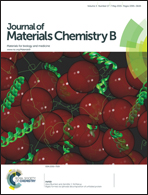Enhanced chitosan–DNA interaction by 2-acrylamido-2-methylpropane coupling for an efficient transfection in cancer cells†
Abstract
Gene therapy is the treatment of human disorders by the introduction of genetic material to specific target cells of a patient. Chitosan and its derivatives show excellent biological properties including biocompatibility, biodegradability and nonallergenicity. Primary amines of chitosan are responsible for its cationic nature and hence binding and protection of DNA for intracellular delivery. But the transfection efficiency of chitosan based gene transporters is severely hampered by its poor physical properties such as low water solubility and high viscosity. In this study, primary amines of low molecular weight (LMW) chitosan were coupled with 2-acrylamido-2-methylpropane sulphonic acid (AMP) making it water soluble for its application in gene delivery. AMP modified chitosan (CSAMP) showed an enhanced interaction with DNA and a higher buffering capacity due to AMP amines leading to a higher transfection efficiency in cancer cells (A549, HeLa and HepG2) compared to native chitosan and Lipofectamine®. In vivo studies in Balb/c through intravenous injection demonstrated a higher luciferase expression compared to LMW chitosan.


 Please wait while we load your content...
Please wait while we load your content...